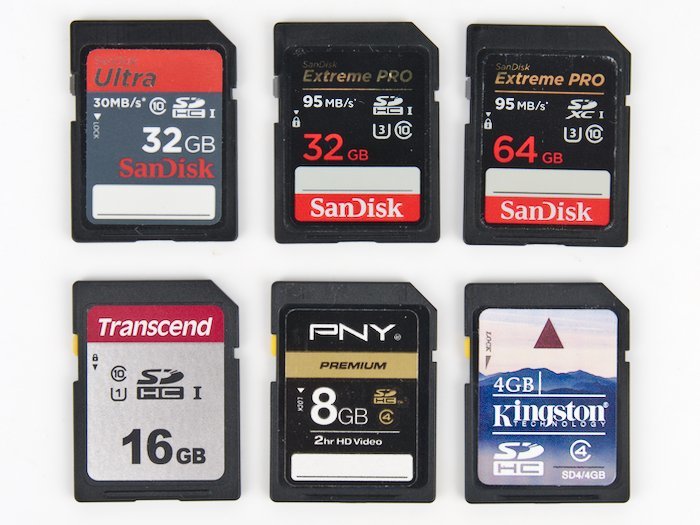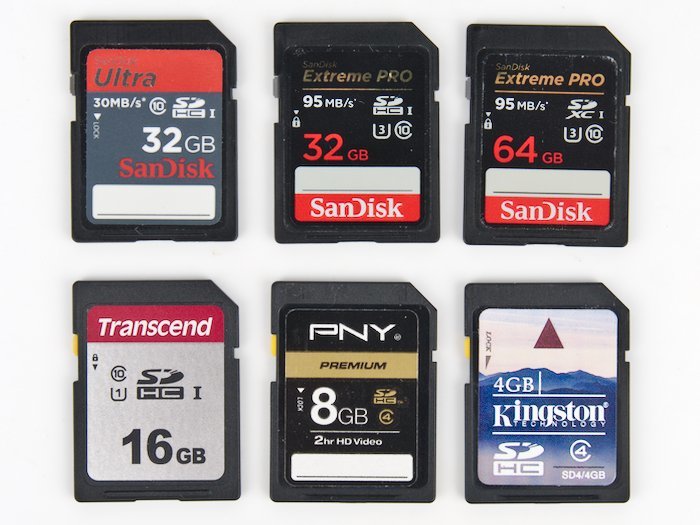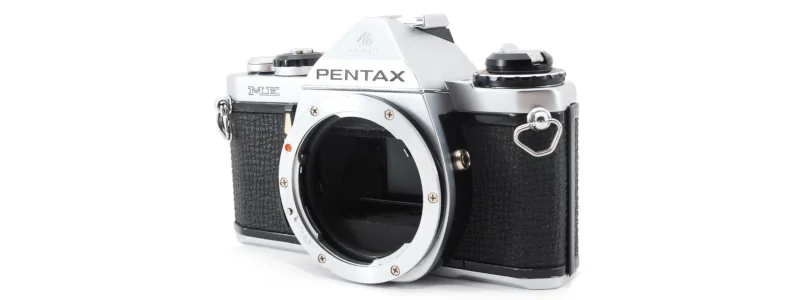
5 Great Pentax ME Lenses for Film Photographers
- Nathaniel Stephan
- Pentax me
- October 26, 2022
Table of Contents
The Pentax ME is a fantastic 35mm SLR camera. This page is going to go into the 5 best lenses for the Pentax ME, as well as a handful of substitute options.
Affiliate Advertising Disclosure
Outside the Shot is a participant in the Amazon Services LLC Associates Program, an affiliate advertising program designed to provide a means for sites to earn advertising fees by advertising and linking to Amazon.com.
As an eBay Partner, I may be compensated if you make a purchase. I also participate in affiliate advertising programs with KEH and Adorama. More can be found on the Affiliate Disclosure page.
The following is the list of the 5 best lenses for the ME:
- Kit Lens - SMC Pentax-M 50mm f/1.7
- Wide Angle Lens - SMC Pentax-M 28mm f/2.8
- Portrait Lens - SMC Pentax 135mm f/2.5
- Zoom Lens - Vivitar Series 1 28-90mm f/2.8-3.5
- Macro Lens - SMC Pentax 100mm f/4 Macro
The best Pentax K mount lenses are grouped by price range and kind of photography. There are many proposed possibilities to choose from that are in price ranges suitable for the cost of the camera.
Standard Focal Length Lenses
This is a few 50mm focal lengths that are compatible with the ME. When the camera was sold as new, there was frequently an offer bundling a 50mm lens as kit for a discount.
The 50mm is known as a standard lens since the angle of view for the lens is similar to what the human eye sees.
SMC Pentax-M 50mm f/1.7
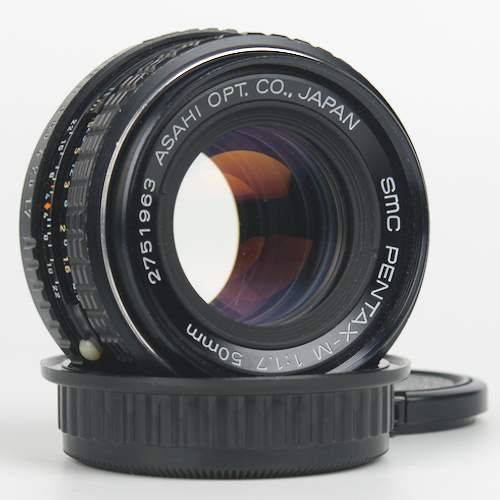
- “Kit” lens for the ME.
- Awesome value.
- Light, small, and compact.
- 49mm front filter threads.
See current price and more information on:
If it was not included, a capable first lens to buy for the ME is the SMC Pentax-M 50mm f/1.7. The 50mm f1.7 is easy to find, is lightweight, has terrific image output, is low-priced, and portable . It is the most used lens on the camera.
{You can also purchase the second version, the SMC Pentax-A 50mm f/1.7|The next version, the SMC Pentax-A 50mm f/1.7, is also a good choice}.
SMC Pentax-M 50mm f/1.4
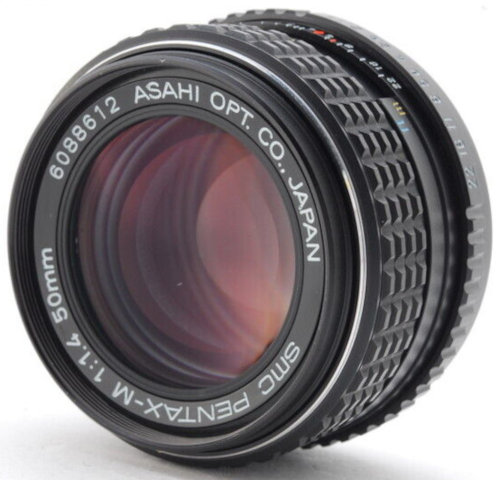
- Exceptional optics.
- Optical multi-coatings to improve performance.
- Easy to find.
- Comparatively inexpensive.
See current price and more information on:
At the added cost of size and weight, the SMC Pentax-M 50mm f/1.4 is approximately a stop faster than the f/1.7. Expect to pay more than you would for an f/1.7 or f/2 lens. The former version, SMC Pentax, and subsequent version, SMC Pentax-A, will both work with the ME.
SMC Pentax 50mm f/1.2
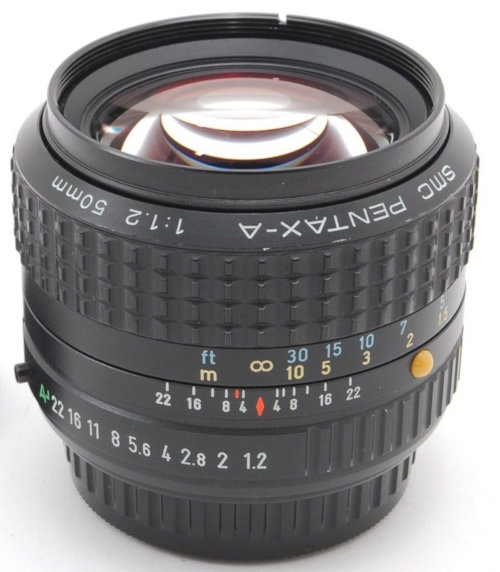
See current price and more information on:
Just like competing camera companies, Pentax developed a 50mm halo lens. The resulting SMC Pentax 50mm f/1.2 is a quite large, fast, and pricey piece of glass.
The lens can be tricky to come across because it will work on Pentax DSLRs so the desirability extends beyond usage with 35mm film cameras. If you want to track down one you’ll need to check and look at what is available for purchase through weeks or months.
Wide Angles
SMC Pentax-M 28mm f/2.8
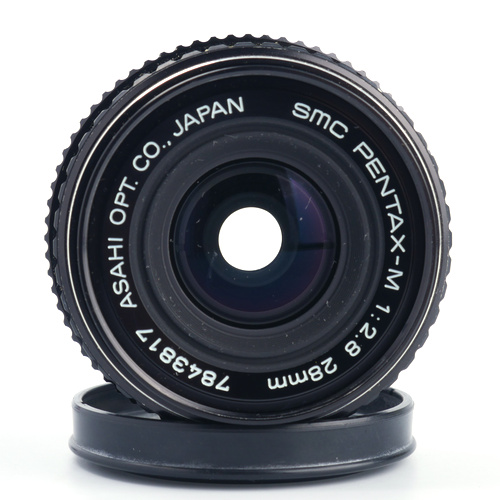
- Great combination with a 50mm lens.
- Super Multi Coating (SMC) to improve performance.
- Many copies can be found.
- Relatively low-priced.
See current price and more information on:
Not the best option, the SMC Pentax-M 28mm f/2.8, is still a good choice. In fact, many may not actually consider it a wide angle lens. However, it is significantly less expensive when compared to any wider option.
There’s an abundance of wider focal lengths to select from, but they’re possibly way more expensive or third-party options have obvious barrel distortion. Also, it is easy to see optical defects like chromatic aberrations in third-party offerings.
Alternatives
The general relationship for pricing is easy to understand. The wider the field of view, the more expensive the lens is going to be. Lenses with large apertures will also have higher prices.
Take into account, that vintage wide angle lenses don’t include corrections that modern wide angle lenses have. The issue you are most likely to see with vintage wide angles is going to be apparent barrel distortion.
- SMC Pentax-M 20mm f/4
- SMC Pentax-M 28mm f/2
- SMC Pentax 18mm f/3.5
- SMC Pentax 24mm f/2.8
Portrait & Telephoto Lenses
SMC Pentax 135mm f/2.5
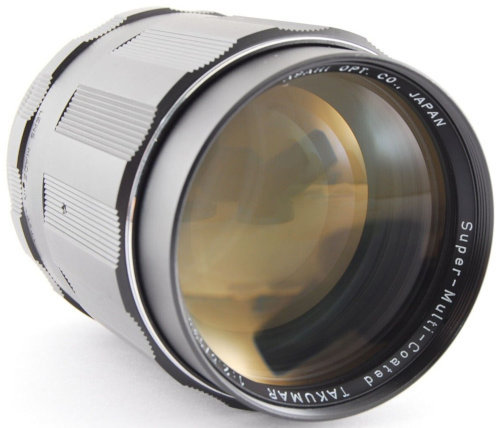
- 85mm substitute.
- Excellent value.
- Relatively inexpensive.
- Widely available.
See current price and more information on:
The 85mm focal length was not as frequently used as they are today compared to when the ME was initially released in 1976. On account of being less expensive, 100mm and 135mm focal lengths were more frequently used.
The difference in price can be seen when you view what’s available online.
More Options
There’s an abundance of telephoto lenses to select from. Focal lengths longer than 135mm and 85mm lenses will be expensive.
- SMC Pentax 85mm f/1.8
- SMC Pentax 85mm f/2.2 Soft
- SMC Pentax 105mm f/2.8
- SMC Pentax 120mm f/2.8
Zoom Lenses
Before the introduction of autofocus, in the early 1980s, there were a small number of lenses made by third-party manufacturers that performed better than Pentax’s offering.
Many of the best performers were released under the Vivitar brand name. Any zoom lens that has the Vivitar Series 1 branding on it is going to have the best optics you’ll see from a vintage zoom.
Sadly, obtaining one of these lenses in usable condition can be very challenging. Beyond that, no older zoom offers exceptional performance. If you find a copy for sale that is cheap enough, it may be worth purchasing.
Vivitar Series 1 28-90mm f/2.8-3.5
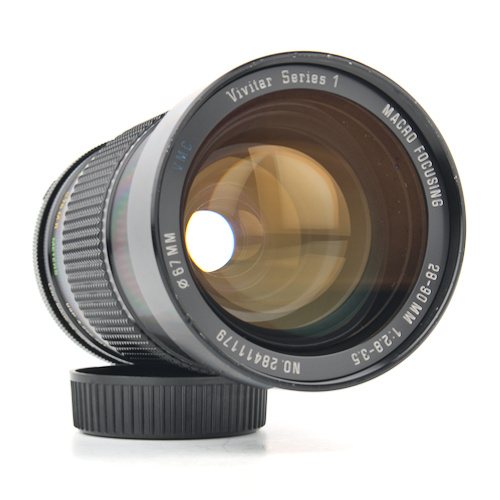
See current price and more information on:
More Options
Here are more options that you can consider if you need a zoom for your ME. None of them are going to be incredible, and you’d most likely be better off purchasing a couple of prime lenses instead.
- SMC Pentax 85-210mm f/3.5
- Vivitar Series 1 70-210mm f/3.5
- SMC Pentax 45-125mm f/4
Pentax Macro Lenses
Macro lens selections for the Pentax ME suffer from availability problems. The supply of Pentax K mount choices is limited, which increases prices higher than you’ll pay for equivalent Canon FD mount or Nikon F mount options.
SMC Pentax 100mm f/4 Macro
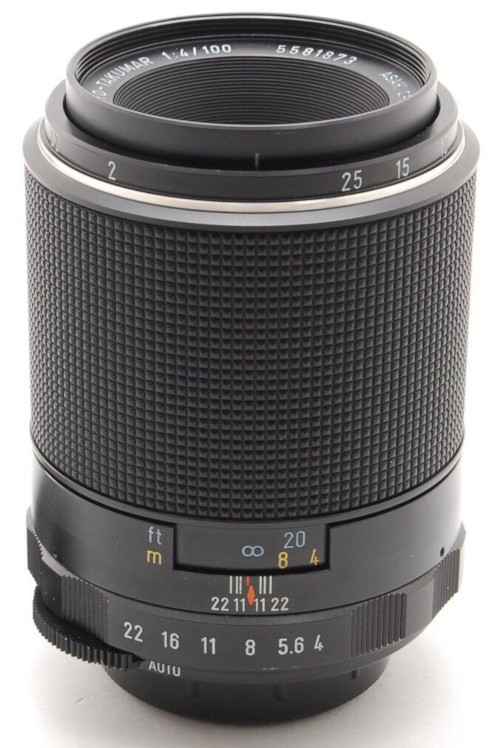
- Ideal focal length for 1x magnification.
- Widely available.
- Mediocre value.
See current price and more information on:
A few people online have experienced balsam separation of the front doublet. This is worrying because even a little separation will increase gradually and eventually make it unusable. If you see any signs of balsam separation, avoid that lens and continue shopping.
Vivitar 55mm f/2.8 Macro
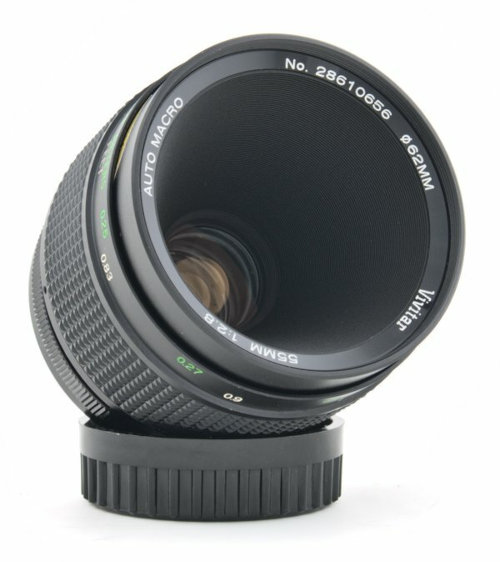
- The second best vintage macro lens I’ve used.
- An outstanding lens for close-up photography.
- Can achieve life-size magnification without needing an extension tube.
See current price and more information on:
My favorite vintange macro lens I have owned, the 90mm Vivitar, was produced with a variety of mounts. However, it will be challenging to find a copy that has a Pentax K mount.
The Vivitar 55mm is my second favorite vintange macro. Keep in mind that it does have a smaller working distance than the 90mm. It is a good choice for close-up and table top photography, but it is not the best choice if you would like to capture macro shots at 1x magnification.
Both of the Vivitar macros were manufactured by Komine and were marketed under several brand names. If you decide to look for a copy also search under the Elicar, Panagor, Quantaray, Rokunar, and Spiratone brand names.
There is a Vivitar 90mm Macro Review and a [/vivitar-55mm-f-2-8-macro-lens-review](Vivitar 55mm Macro Review/).
For shooting photographs at life-sized magnification, 90mm-105mm focal lengths will be the best choice. You’ll have enough working distance to allow the use of flash, while staying away from increased weight and excessive costs that come with longer focal lengths.
More Alternatives
- SMC Pentax-M 50mm f/4 Macro
- Lester A Dine 105mm f/2.8 Macro Lens Review
- Vivitar 90mm f/2.8 Macro Lens Review
Used Pentax Lens Prices
Prices change all the time depending on supply and interest in manual focus glass. Over the last several years, film photography has grown in popularity, which has increased prices.
More pricing pressure stems from Pentax DSLR users purchasing and collecting lenses. Third party manufactures generally do not produce lenses for the K-mount, unlike the Canon EF or Nikon F mounts.
Marketing circumstances are continuously changing, and sudden events can lead to big price movements. Even so, the relative prices between choices should be the same.
Checking several sites is a very good way to get correct prices. If you’re lucky enough to discover a terrific deal, purchase it since the best deals tend not to last very long.
What Lens Mount Does the Pentax ME Use?
The Pentax ME uses the Pentax K lens mount.
Released in 1975, cameras being produced today are still using the Pentax K mount. It’s a replacement for the M42 screw mount That was used on cameras like the Asahi Pentax Spotmatic. Over the years changes have been made to add autofocus, CPU contacts, metering information, and electronically controlled apertures.
Provided that a lens has a aperture ring, it will be backward compatible with Pentax film cameras. Even so, it doesn’t make sense to waste money on costly features that will not be able to be used by the camera. The only exception would be if you also own Pentax DSLRs.
It is also possible to use the previous M42 lenses by using an adapter. People like to do this as some of the M42 Takumar lenses are spectacular. Even so, I would not recommend doing this as getting them without tight focus rings can be hard.
Lens Cap Size
The standard filter ring thread and lens cap diameter used on most vintage manual focus Pentax K mount lenses is 49mm. Lenses were sold with slip on caps, not the more prevalent center-pinch kind found today. Looking around, you will discover a lack of original lens caps sold with the lenses.
Keep in mind big front elements will need to use bigger filters and caps.
The advantage of having a standardized filter thread size is that you only need to own one set of filters.
Pentax-M vs Pentax-A
SMC Pentax and Pentax-M lenses were designed to include a stop-down coupler that provides the camera to have a mechanical linkage to the lens. The stop-down coupler enables the camera to know the aperture is set to so that the light meter is able to meter properly without having to rely on stop-down metering.
The Pentax-A series added the feature for the camera to control the aperture in the lens. Which means cameras that are compatible with the Pentax-A changes have the capability to do shutter priority and aperture priority modes.
However, because that capability isn’t supported by the camera, it does not make financial sense to spend money on features the camera can’t use.
